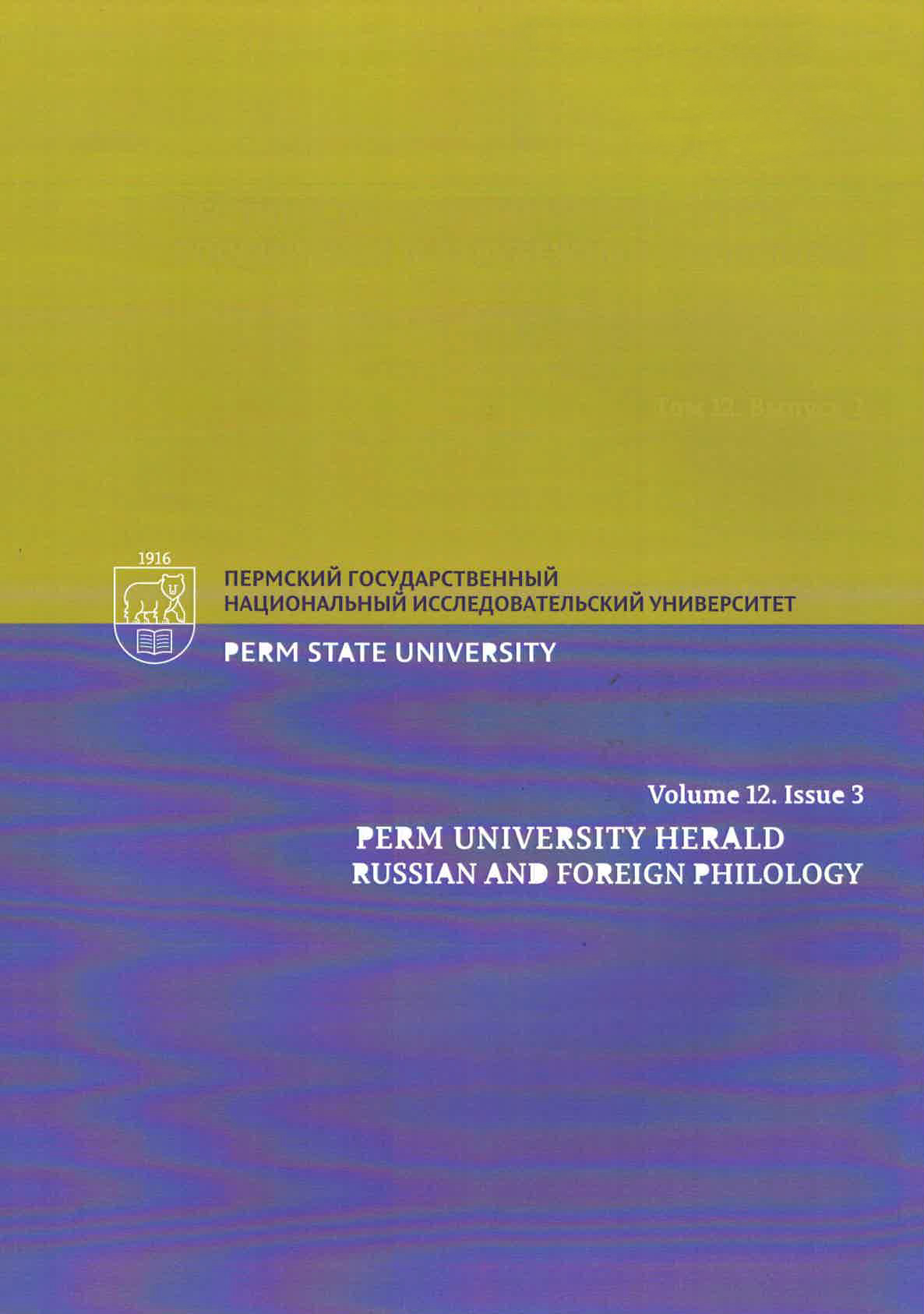MATERIALS TO ETYMOLOGY OF THE KOMI-PERMYAK WORD «BICHUL’» (‘STRAWBERRY’)
DOI:
https://doi.org/10.17072/2073-6681-2019-3-19-26Keywords:
Komi-Permyak language, lexicology, etymology, bichul’, strawberry.Abstract
The article presents fragments of the historical-etymological and structural-semantic analysis of the Komi-Permyak word bichul’ (Russ. ‘klubnika’; Eng. ‘strawberry’) that is found in two textbooks of the Russian language for the Komi-Permyaks (1896 and 1906). The analysis is performed both at the synchronous level (comparison with the language of Komi-Permyak publications of the 1860–1900s) and at the diachronic level (comparison, on the one hand, with the language of written monuments of the 1780–1840s, on the other hand – with the norms of the literary Komi-Permyak language reflected in various dictionaries of the 1980–2000s). Since nowadays different berries are called klubnika in different parts of Russia, the paper attempts to find out what exactly in the Western Urals could be understood as klubnika at the turn of the 19th and 20th centuries. For this purpose, Russian national and dialect words with meanings klubnika (‘strawberry’) and zemlyanika (‘wild strawberry’) are involved in comparison, and a brief history of their functioning in the Russian language is traced. According to the author’s version, the Komi-Permyak word bichul’ is literally translated as ‘fiery goiter’ or ‘fiery (bird’s) goiter’. In this connection, the Komi-Permyak set phrase bichul’ka sina (‘pop-eyed’) is considered – not only because of the formal similarity but also because exophthalmus, goiter and tachycardia are characteristic syndromes of the diffuse toxic goiter disease. There are also mentioned the Komi-Permyak hapax legomenon of the late 18th century sela oz (‘strawberry’), the modern Komi-Permyak dialect word s’ölaoz (‘Rubus arcticus’), which both literally mean ‘hazel-grouse wild strawberry’, as well as typologically similar names in Russian dialects. At the end of the article, the author raises a question of possible connection between the Komi-Permyak word bichul’ (‘strawberry’) and the modern Komi-Permyak northern dialect word bichul’ (‘door spin’, with variants bichuli, bichul’ka, bichul’ki) with its extensions in the Komi dialect continuum (see the words of the Upper Sysola dialect of the Komi-Zyryan language bichul’ – ‘gag, door bolt, wrapping, spin’, bichul’ka ‘float (of a fishing rod)’). In addition, there is mentioned the Russian dialect word bichul’ki (‘detail of a weaving loom’), which is recorded in the substrate Northern Permyak area.References
Баталова Р. М. Ареальные исследования по восточным финно-угорским языкам (коми языки) / отв. ред. К. Е. Майтинская. М.: Наука, 1982. 168 с.
Беликов В. И. Сравнение Петербурга с Москвой и другие соображения по социальной лексикографии // Русский язык сегодня. Вып. 3: Проблемы русской лексикографии / отв. ред. Л. П. Крысин. М.: Ин-т рус. яз. РАН, 2004. С. 23–38.
Гайдамашко Р. В. Из наблюдений над коми-пермяцкой лексикой в «Первоначальном учебнике русского языка для чердынских пермяков» 1906 г. // Вестник Пермского университета. Российская и зарубежная филология. 2018. Т. 10, № 3. С. 28–41. doi 10.17072/2037-6681-2018-3-28-41
Мехова Е. Клубника? Нет – земляника // Наука и жизнь. 2008. № 4. С. 86–87.
Овеснов С. А. Местная флора. Флора Перм-ского края и ее анализ: учеб. пособие по спец-курсу. Пермь: Перм. гос. ун-т, 2009. 171 с.; ил.
Пономарева Л. Г. Речь северных коми-пермяков. М.: Языки Народов Мира, 2016. 514 с. + цв. илл.: 8 с.
Просянникова Е. Б. Майник двулистный // Малая энциклопедия Забайкалья: Природное наследие / гл. ред. Р. Ф. Гениатулин. Новосибирск: Наука, 2009. С. 317.
Федосеева Е. Н. Лексика северного наречия коми-пермяцкого языка. Сыктывкар: Ин-т языка, литературы и истории Коми НЦ УрО РАН, 2015. 196 с.
References
Batalova R. M. Areal’nye issledovaniya po vostochnym finno-ugorskim yazykam (Komi yazyki) [Areal studies on eastern Finno-Ugric languages (Komi languages)]. Ed. by K. E. Maytinskaya. Moscow, Nauka Publ., 1982. 168 p. (In Russ.)
Belikov V. I. Sravnenie Peterburga s Moskvoy i drugie soobrazheniya po sotsial’noy leksikografii [Comparison of Petersburg with Moscow and other observations on social lexicography]. Russkiy yazyk segodnya. Vyp. 3. Problemy russkoy leksikografii [Russian language today. Issue 3. Issues of Russian lexicography]. Ed. by L. P. Krysin. Moscow, V. V. Vinogradov Russian Language Institute of the Russian Academy of Sciences Publ., 2004, pp. 23–38. (In Russ.)
Gaidamashko R. V. Iz nablyudeniy nad komi-permyatskoy leksikoy v ‛Pervonachal’nom uchebnike russkogo yazyka dlya cherdynskikh permyakov’ 1906 g. [Some observations on the Komi-Permyak lexis in the ‛Elementary textbook of Russian language for Cherdyn Permyaks̕ (1906)]. Vestnik Permskogo universiteta. Rossiyskaya i zarubezhnaya filologiya [Perm University Herald. Russian and Foreign Philology], 2018, vol. 10, issue 3, pp. 28–41. doi 10.17072/2037-6681-2018-3-28-41 (In Russ.)
Mekhova E. Klubnika? Net – zemlyanika [Strawberry? No – wild strawberry]. Nauka i zhizn’ [Science and Life], 2008, issue 4, pp. 86–87. (In Russ.)
Ovesnov S. A. Mestnaya flora. Flora Permskogo kraya i ee analiz: ucheb. posobie po spetskursu [Local flora. Flora of the Perm region and its analysis: textbook for a special course]. Perm, Perm State University Press, 2009. 171 p., illustrations. (In Russ.)
Ponomareva L. G. Rech’ severnykh komi-permyakov. Monografiya [The speech of northern Komi-Permyaks. Monograph]. Moscow, Editorial URSS Publ., 2016. 514 p. + color illustrations: 8 p. (In Russ., Komi-Perm.)
Prosyannikova E. B. Maynik dvulistnyy [Maianthemum bifolium]. Malaya entsiklopediya Zabaykal’ya: Prirodnoe nasledie [Small encyclo-paedia of the Trans-Baikal region: Natural heritage]. Ed. by R. F. Geniatulin. Novosibirsk, Nauka Publ., 2009, p. 317. (In Russ.)
Fedoseeva E. N. Leksika severnogo narechiya komi-permyatskogo yazyka [Lexis of the Komi-Permyak northern dialect]. Syktyvkar, Institute of Language, Literature and History, Komi Science Center of the Ural Branch of RAS, 2015. 196 p. (In Russ.)




